The Changing Faces of Concrete
by Joyce Volmer Brown
photos courtesy of Sonoma Stone.com
We all remember the story of the ugly duckling. Oh come on, sure you do – the one where the little ugly duckling is magically transformed into a beautiful swan. Well, here’s a real-life transformation story that has nothing whatsoever to do with ducklings or swans, but rather, with concrete. (Which can’t float nearly as well as an ugly duckling, but can be made beautiful.)
Not long ago, nondescript gray concrete was relegated to some pretty limited, ugly duckling like uses: primarily drab foundations, basements, sidewalks and driveways. Today, concrete has come into its own – with limitless faces and countless applications.
New chemical stains and coloring pigments allow concrete to be stained to match any hue. A wide variety of stamping and brushing techniques provide endless textures as well. Tactile concrete can be polished to a high-luster that replicates the look of polished marble, granite or even metal, or left with a casual, rough texture. Colored aggregate can be added to the concrete mix or “seeded” into the top layer. Bits of glass, pieces of metal, fossils or coins may be embedded. Artisans may paint and stencil concrete.
On the exterior, stamped concrete can resemble brick, slate or flagstone, at a lower cost than the actual materials – adding warmth and character to entries, patios, walkways, retaining walls, borders and pool decks. Colors and patterns are often chosen to blend with other elements at the residence.
Concrete can be molded to form artificial rocks to enhance water features and landscapes. Because of the equipment, effort and expense required to haul large boulders into a backyard, many designers and contractors are turning to concrete faux rocks, which can be built on site. A home’s walls can be covered with built-in place stone veneers – often at a lower cost than installing manufactured stone.
Inside, a kaleidoscope of colors and textures allows designers to create one-of-a-kind finishes and to coordinate surfaces with other materials within a room. This tremendous versatility is being expressed in multiple applications: kitchen countertops, sinks, bathtubs, floors, fireplace surrounds and even furniture.
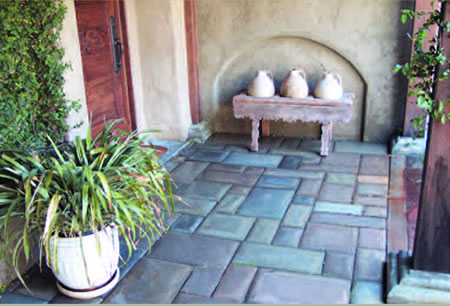
Sonoma’s Soft Stone pavers may remind onlookers of a trip to Europe, where generations of people, animals and carts wore the edges of old roads and church stones.
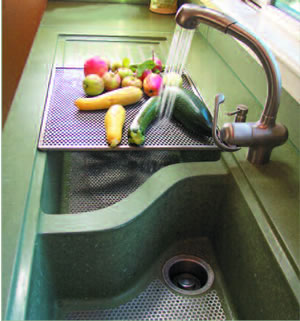
Sonoma Cast Stone’s Chef Sink provides fluid lines with functionality. A perforated stainless steel bottom protects the sink from years of pot and pan abrasion. A stainless steel rack slides across the sink.
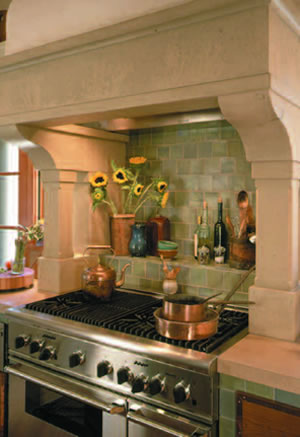
A substantial concrete surround lends character and warmth to a commercial range.
While interior use of concrete can compare to natural stone in cost, it is less limited in color, thickness or pattern – and it can be molded in nearly unlimited shapes. Concrete floors are easy to clean and may be a better choice than carpeting for families with hay fever, dust or mold allergies. They also work well with radiant floor systems.
One of the concerns people often have when discussing concrete is cracking. Jim Peterson, President of Concrete Network comments, “Although concrete is prone to crack, this can largely be controlled by incorporating control joints into a decorative scoring design. Because indoor concrete is not subjected to drastic temperature changes, it is less likely to crack, but small hairline cracks may appear in time. If they become noticeable or grow, they can be filled with polyester-based resins colored to match the surface.”
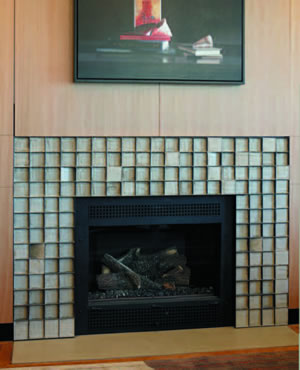
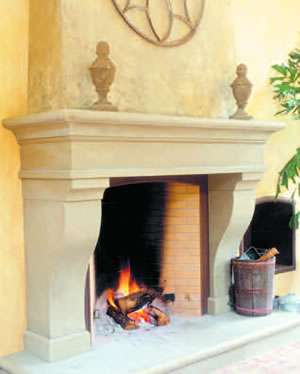
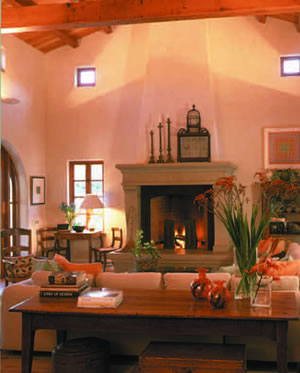
These fireplace surrounds by Sonoma Cast Stone of Sonoma, California, show concrete’s versatility...
from sleek Contemporary to Old World to Southwestern.
Peterson says concrete upkeep is minimal. “Each countertop craftsman will provide his own instructions, but the norm is a fresh coat of sealer will need to be applied annually. Floors usually require a wax finish to be applied once a year. A polished concrete floor may eventually lose its luster, but its gleam may be restored by buffing.”
Like stone, concrete requires proper sealing and careful maintenance. Hot pots should not be placed directly on concrete countertops. Some designers incorporate special trivets into the countertops; otherwise, hot pads should always be used. Acidic liquids, such as citrus juices or vinegar, left on unsealed concrete can etch the surface. Similarly, oil and fat may soak in. For these reasons, homeowners should realize concrete is not a static material. It will continue to evolve over time, acquiring a patina with its own character.

